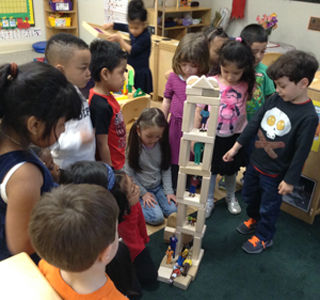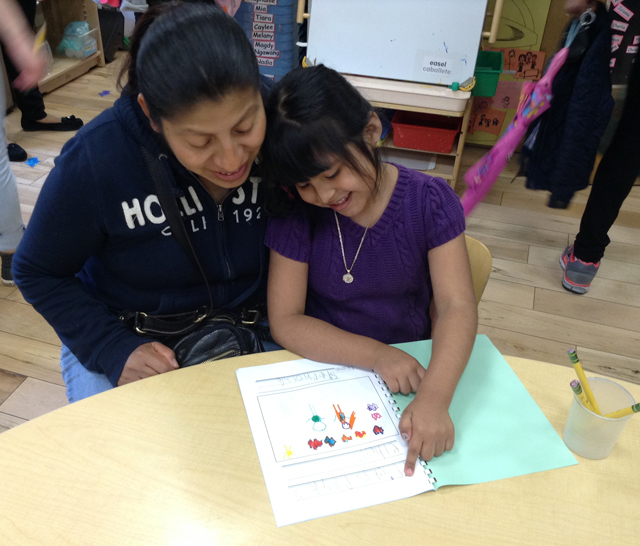The Harvard Family Research Project separated from the Harvard Graduate School of Education to become the Global Family Research Project as of January 1, 2017. It is no longer affiliated with Harvard University.

|
September 17, 2014 Sharing Assessment Data With Preschool Families in Preparation for KindergartenNell Shapiro
|
FINE Newsletter, Volume VI, Issue 4
Issue Topic: Around the Clock: The Power of Anytime Learning
Voices From the Field
|
SNAPSHOT: Neighborhoods Served: East Side of Manhattan – majority of families from East Harlem |
I was drawn to Lenox Hill Neighborhood House, the Head Start center in New York City where I currently teach, by the school’s guiding belief that, to best support children’s growth and preparation for kindergarten, we must work in partnership with each child’s family. The ways that families become engaged in children’s learning over time are formed in the early years. For educational and child care organizations at all levels, this includes sharing data with families in meaningful ways.
As a preschool teacher, I have found that sharing data on children’s progress with families is one of the most important yet difficult aspects of my responsibilities. This work entails defining explicit learning objectives. It involves communicating these objectives to families in clear ways so that they can accurately reflect on their child’s progress. It requires helping families set appropriate short- and long-term educational goals for their children so that they are ready for kindergarten. It also means providing them with the tools they need to effectively support children’s learning in the home. Crucial to the success of sharing data with families is developing trusting relationships with families in order to have open, honest, and ongoing conversations.
MY TEAM’S DATA SHARING PROCESS
My teaching team and I do not wait until family–teacher conference time—which, for us, spans an entire month—to begin conversations with families around children’s progress. Instead, through monthly group classroom meetings, we share data and school readiness goals with families on a regular basis throughout the year. Because opportunities for data sharing are not limited to once or twice a year, we are able to hold meetings and schedule conferences at times that make sense for busy families’ schedules. Figure 1 shows what we do before, during, and after our family–teacher conferences.
.jpg)
Figure 1. Before, During, and After Family–Teacher Conferences
TIPS FOR ENGAGING FAMILIES IN THE DATA SHARING PROCESS TO SUPPORT SCHOOL READINESS
- Share classroom assessment data with families on an ongoing basis: My teaching team and I hold a group classroom meeting with families each month during which we share school readiness goals and curriculum related to the current thematic unit. Three times a year, we share group assessment data at these meetings.
- Provide opportunities for families to pass on ideas to other families about how to support learning in the home: During our monthly classroom meetings with families, we facilitate conversations among families in which they share ideas for how they might use materials and address learning objectives at home. For example, families discuss ways to incorporate measuring and counting when preparing dinner with their children. They also share examples of questions they ask or things that they say as they read aloud at bedtime. Our monthly classroom newsletters highlight some of the best ideas that come from these meetings so that any families who can’t attend are still able to get the information.
- Make children’s work available for review on a regular basis: Beyond bulletin boards that display children’s work alongside a description of the task and the standards demonstrated, we bring random samples of work to monthly classroom meetings to illustrate the type of work children are doing in connection with the learning objectives. We also send children’s portfolios home three times a year.


Two children describe their apartment tower. We often share photos like this with families to illustrate their child’s work and creativity.
A mother and a group of children play Memory Match during a Monthly Math Morning.
- Hold regular teaching team meetings to discuss data: In addition to monthly classroom meetings with families, we also hold monthly teacher meetings. At these meetings, the education director and teachers review and discuss schoolwide data reports and family feedback, and share resources and experiences from their classrooms. At year’s end, as a team, we reevaluate our overall progress and adapt our curriculum and materials to meet the needs of our children and families.
- Invite family feedback on curriculum and instruction: As a teaching team, we consistently incorporate family feedback into individual child and classroom planning. These decisions are based on our formal and informal observations in the classroom as well as suggestions and feedback that families provide. For example, each month we hold Monthly Math Mornings, which give families an opportunity to participate in a hands-on math activity alongside their children. During these activities, families come to see how particular math objectives, like patterning or number sense, are being taught in class. Afterward, families can play these same math games at home with their children. The idea for these workshops came from a father who suggested that we invite families into the classroom for academic activities. His older child’s elementary school welcomes families in for math and literacy activities once a month, and he thought that initiating a similar event would be a good introduction for families in preschool as well. These events have been a big success, and an extra benefit is that children love a chance to learn alongside their families! For the families that don’t have time to attend the Monthly Math Mornings, we leave premade materials and instructions for them to take home and review later.
| THE SCHOOL READINESS AND FAMILY ENGAGEMENT COMMITTEE (SRFEC) According to Janette Newman, education director of the Lenox Hill Neighborhood House Early Childhood Center, and Batya Novick, director of family services, the SRFEC was developed to involve all stakeholders in children’s lives in the ongoing development of school readiness goals. Because school readiness depends on children’s learning in both the classroom and at home, this committee considers best practices in family engagement that will support children’s development and growth. In these meetings, participating teachers and families who are on the committee have an opportunity to hear about schoolwide progress assessments from the education director. The family services director also presents parent–family community engagement objectives to the group. The committee members then discuss how school staff can best support children, making suggestions for both the school environment and resources for families to use with their children at home. Recommendations of the committee thus far have ranged from specific programming to broader shifts in perspectives. One mother, for example, expressed that, for some families, the importance of family engagement in preparing their child for kindergarten is unclear. While she believes that most families value being informed of their child’s progress and appreciate the resources for home that teachers provide, not all families realize how their engagement at school and home will help their children to be more successful. She recommended finding ways to clarify and reinforce this. More-specific suggestions from participating families include helping to build stronger social support systems between families, and translating child outcomes into meaningful activities and areas of focus for families to better support children at home. |
CONCLUSION
Contributing to a cohesive team of teachers, social workers, and families dedicated to supporting each child’s development is at the core of my work in promoting children’s school readiness. School readiness encompasses not only a child’s preparedness for kindergarten but the family’s as well. My goal is that families understand their role in their child’s learning and develop the confidence to effectively engage in the education process. I help them achieve these objectives by building relationships with families that center on sharing information in meaningful ways. Through this process, my team and I construct a strong foundation for a family’s role in their child’s education, both here and elsewhere, after their years at Lenox Hill Neighborhood House Head Start.
 |
| A child shares a book she wrote with her mother, giving her parent the opportunity to see her progress in writing over the course of the year. |
Nell Shapiro is a lead teacher at Lenox Hill Neighborhood House Early Childhood Center in New York City. In addition to her work in the classroom, she is working in collaboration with the center’s family services department to build systemic and measurable family engagement efforts for all classroom teachers and social workers.
This resource is part of the September FINE Newsletter. The FINE Newsletter shares the newest and best family engagement research and resources from Harvard Family Research Project and other field leaders. To access the archives of past issues, please visit www.hfrp.org/FINENewsletter.
